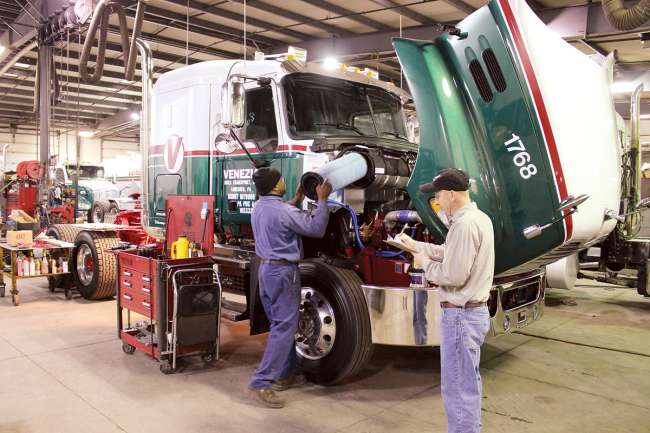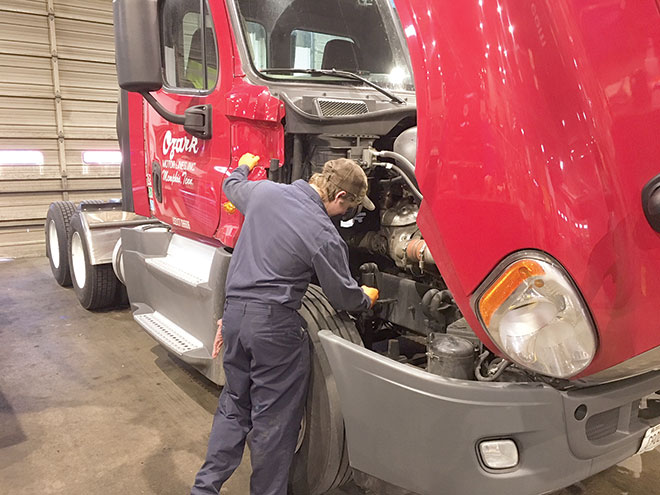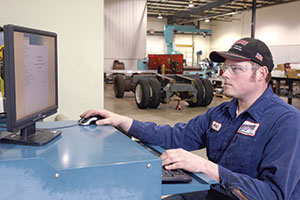Maintenance Shop Management

With the increasing complexity of modern trucks and an even higher premium placed on drivers’ time, Glen McDonald, maintenance director at Ozark Motor Lines, knew he needed to maximize shop labor and move trucks through his fleet’s maintenance shops more quickly, all of which required an updated approach.
“In the past, we handed work out to the next mechanic who was free, but he wasn’t always the best one to do that job. We got a little more specialized and understood, ‘This guy is good at this, one is good at that,’ ” McDonald said.
The Memphis, Tenn.-based fleet changed its processes, including promoting one of its lead mechanics, who now evaluates and assigns incoming work. “He controls the workflow in the shop and he knows his guys,” said McDonald, who, as of press time for Equipment & Maintenance Update, is general chairman of American Trucking Associations’ Technology & Maintenance Council.
Carriers and technology vendors also said information is helping shops determine necessary repairs, prioritize workloads and schedule labor. Telematics has increased the amount of data coming off of trucks in real time. Fleets are able to use that data to schedule repairs and minimize time spent waiting for a technician, which is now more crucial than ever as both the technician and driver shortages worsen.

Work given to technicians at Ozark Motor Lines is assigned based on each technician's strengths. (Ozark Motor Lines)
Ozark estimates an out-of-service truck results in $800 to $1,000 in lost revenue per day for the fleet. Others interviewed for this story provided a similar range.
The driver hours-of-service regulations have applied pressure on shops to service vehicles quickly and keep trucks moving. Any maintenance-related delay can cause drivers to run out of hours or miss delivery windows.
“Being a dedicated specialized fleet, we are required to deliver sometimes with very little wiggle room in delivery times,” said J.P. Venezia, assistant director of maintenance at Venezia Bulk Transport Inc., which is based in Limerick, Pa.
Fault codes are one tool helping shops manage their workloads. The codes provide a brief description of an issue but also offer insight into how long and complicated a repair may be, said Matt Jablon, district service manager for Daimler Trucks North America, which manufactures Freightliner and Western Star trucks and Detroit engines.
Ozark Motor Lines, McDonald said, has gotten better at using diagnostic fault codes to manage repairs and can gauge which need immediate attention and which can wait until the driver can get to a service center.
Fleets also are relaying fault codes to maintenance shops to help expedite service.

Software from TMW allows employees at service centers and fleets to organize their days and create repair orders. (TMW Systems)
“The fleets will contact us and tell us they have a truck with a specific code and ask which shop to get the truck into to make sure we have the parts and everything we need when it arrives,” said Homer Hogg, director of technical service at TravelCenters of America.
TA also created an app so drivers or fleets can drop a repair order in the work queue to expedite service, he added. “It is almost like call-ahead at a restaurant,” Hogg said.
Keeping loads moving is a priority, and at Ozark Motor Lines, technicians ask drivers if they are on a pre-planned load or have the next load assigned. “If they need rest, we can let him rest in an empty truck while we work,” McDonald said.
Venezia said clear communication before equipment arrives at the shop helps carriers speed repairs. “Many times, we can diagnose over the phone and expedite the part to the shop before the unit arrives, keeping the driver moving and keeping the customer supplied with product,” he said.

Within software from TMW, repair orders with top priority are displayed highest in a list of work assignments when technicians log in. (TMW Systems)
Venezia Bulk Transport uses software from TMW Systems to organize the day and create repair orders. The carrier prioritizes trucks based on the needs of the operations department. Divisions that are running short on equipment or have no back-up equipment available are given top billing.
“Being a dedicated specialized fleet, and because absolutely all of our tractors have specific customer dedicated equipment installed on them, it makes it difficult and expensive to have spares sitting for all divisions at all of our 13 locations,” Venezia said.
Many truck makers provide proprietary software to help shops manage work.
Jablon said that Daimler’s software, for example, allows dealers to enter customer and truck information and the type of problem, which increases efficiency. Jablon has been part of a task force of the Technology & Maintenance Council, which drafted a new recommended practice on shop workload and prioritization that is scheduled to be published in TMC’s 2018-19 recommended maintenance practices manual. The task force agreed that rapid repair assessment was key to managing a shop’s workload.
“By doing the triage and looking at the truck as quickly as possible, you get an understanding of the nature of the repair,” Jablon said, noting that allows for better management of resources. “If you don’t manage and space out major repairs, you don’t have the capacity to address a wider variety of repairs.”
Software from Decisiv can help shops filter work assignments by technician ability and skill set, the dollar value of the repair or the estimated time to complete the repair.
“It gives you an idea of what is going on in your shop, how it is prioritized and who is available,” said Peggy Liao, senior director of marketing communications for the company.
“A tech might just get a feed that says, ‘This is the step you need to do next.’ Someone who runs the shop would need to see all of the machines,” Liao said.
Ozark tracks data on its trucks, which can help technicians get ahead of a problem, McDonald said. The carrier recently noticed that belt tensioners were failing, so it added the item to the PM to avoid over-the-road delays and repair costs, which were averaging about $1,000, McDonald said.
And creating additional scheduling difficulties are holiday and vacation seasons.
“Lots of manufacturers close and the equipment is sitting,” Venezia said. “When the equipment sits without a driver waiting, it is the perfect opportunity to perform scheduled and non-scheduled maintenance.”
“Unfortunately, at that same time, techs want off as well, as we all would,” Venezia said.
Meanwhile, TMW offers software focused on predictive maintenance, which enables fleets to anticipate and address potential breakdowns and service needs before they occur. It can recommend a troubleshooting path for current and future failures based on the previous history, reducing the time it takes to diagnose and correct a problem, said Greg Peck, product manager at TMW.
Shops can mine repair data to get a better understanding of their performance and apply corrective actions, such as ensuring the right parts and tools are available, DTNA’s Jablon added.
Venezia Bulk Transport established specific timeslots for preventive maintenance and major and minor repairs, which are dictated by operations and customer needs at each location, Venezia said.
TravelCenters of America uses a “staging process” and slots trucks in certain bays based on the types of jobs and how long they take.
“We tend to put jobs that will take longer in an area that won’t tie up our throughput,” Hogg said, adding that shop bays should be set up to improve efficiency.
“Everything you need conceivably should be in that space,” he said. “The technician shouldn’t have to walk out of that frame to stop and start that job.”
Shops must juggle day-to-day maintenance needs with other scheduled work.
Ozark Motor Lines tries to schedule new truck and trailer deliveries throughout the year so the fleet can in-service the trucks without getting overwhelmed. “You have to get the new truck decaled, permitted and ready,” McDonald said, adding that they also have to move drivers into the newer trucks and get the used trucks ready to sell. “That is a lot of busy work for us.”
TMW’s Peck also said work may increase during the year when fleets run “campaigns” to update units due to known failures or for seasonal work, such as winterizing equipment.
“It may be an OEM campaign or something you find on your own,” he said, adding that his company’s software can help managers identify the current and future workload to help adjust labor schedules.





